BOEK 3 LAY-OUT
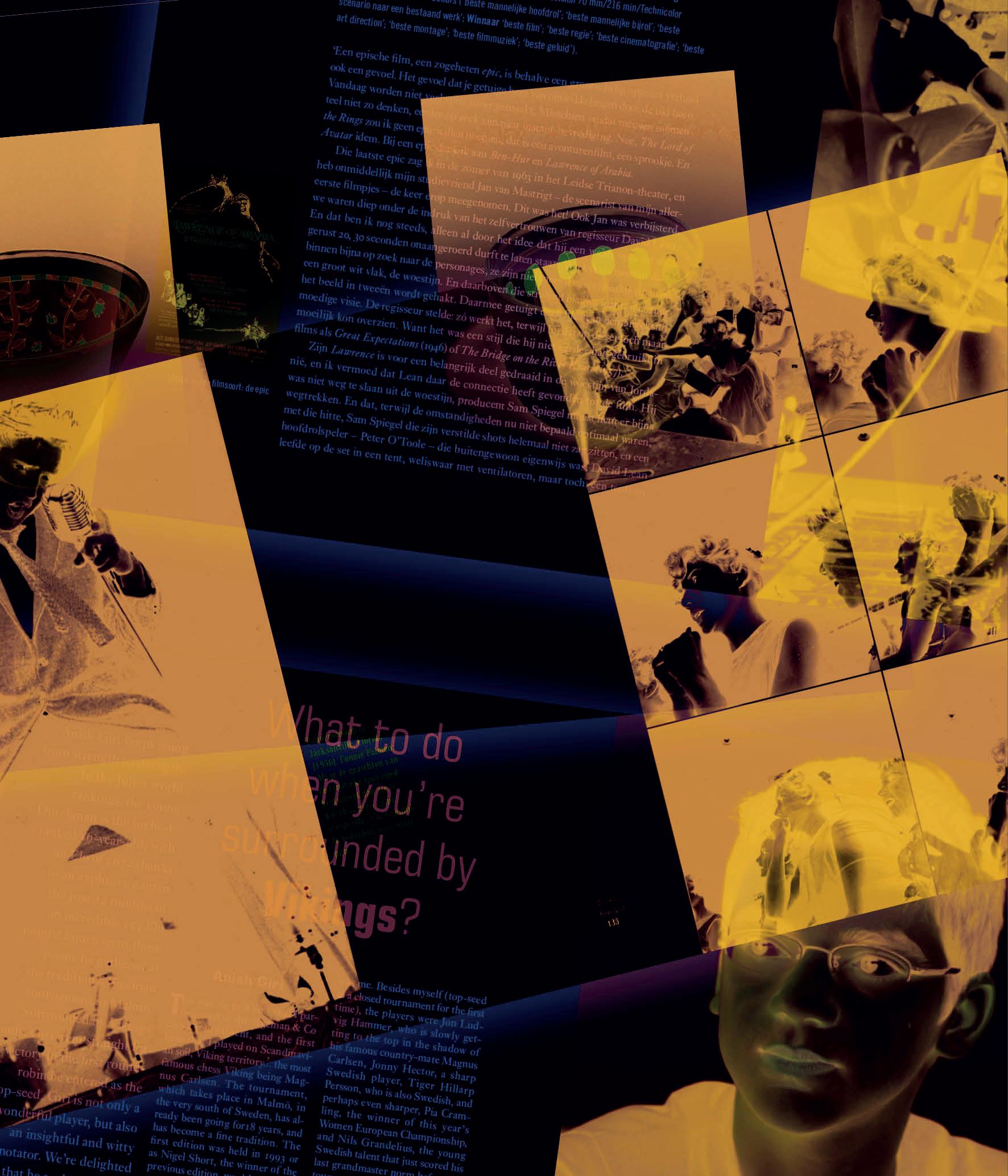
BOEK 3 LAY-OUT
Voorwoord
Dit boek maakt deel uit van een serie waarin een overzicht wordt gegeven van mijn werk. De boeken worden gepubliceerd via issuu.com en van tijd tot tijd aangepast en aangevuld met nieuw werk. Via mail@stevenboland.nl ben ik te benaderen.
Dit deel concentreert zich op de ingewikkelder lay-out en drukwerkbegeleiding.
Geïllustreerde boeken vragen een andere benadering dan een roman. Komt er scanwerk bij kijken en eventueel fotografie. Hoort het boek bij een expositie en is er bijbehorend ander drukwerk. Moet er bij de pers gestaan worden voor een perscontrole.
Soms gaat het om een tijdschrift waarbij de uitvoering uitbesteed wordt en alleen de art-direction aan de orde is. In dit boek een aantal voorbeelden van ingewikkelder projecten.
Veel genoegen gewenst bij het bekijken van dit boek.
Steven Boland, september 2014
uitgever
Meulenhoff
auteur
Rob van Scheers
formaat
21x21
jaar van publicatie
2010
bijzonderheden
Dit boek van Rob van Scheers kwam bij Meulenhoff uit in zijn derde editie. Ook de tweede editie bij UMCO werd door mij vormgegeven en deze editie heeft naast wat aanvullingen nu ook een omslagontwerp van mijn hand. Voor het binnenwerk heb ik intensief samengewerkt met de auteur voor wat betreft de keuze van de foto’s. Alle zwart-wit afbeeldingen in het boek werden omgezet in full-color om zo een dieper en rijker zwart te krijgen wat beter past bij het kleurwerk ernaast. Bij het boek werd een CD geleverd met daarop covers van Elvis door Nederlandse artiesten.

























uitgever
De Bezige Bij
auteur
Rob van Scheers & Paul Verhoeven
formaat
20x22
jaar van publicatie
2014
bijzonderheden
Feitelijk bestaat dit boek niet aangezien dit omslag nooit gepubliceerd is en door mij na voltooiing van de twee delen Volgens Verhoeven (2013) en Meer Verhoeven (2014) pas gemaakt is. Bij dit boek heb ik een groot deel van het fotomateriaal bij elkaar gezocht en samen met de auteur beoordeeld op geschiktheid. De twee delen Verhoeven sluiten naadloos op elkaar aan en hebben beide dezelfde basis lay-out zij het dat het eerste deel stukken heeft die meestal 4 pagina’s lang zijn en het tweede deel stukken van 6 pagina’s vanwege de grotere hoeveelheid tekst. Elke film in de boeken heeft een eigen hoofdstuk welke door Rob van Schees en mijzelf samen achter het scherm tot in de finesses werd geperfectioneerd in tekst en beeld om zo tot een optimaal resultaat te komen.

Uitstervende filmsoort: de epic
★ Episode 8
Lawrence of Arabia (1962) Deel I

Lawrence of Arabia (1962) ★ Genre: historisch drama ★ Regie: David Lean ★ Producer: Sam Spiegel ★ Scenario: Robert Bolt en Michael Wilson ★ Met: Peter O’Toole, Alec Guinness, Omar Sharif, Anthony Quinn, Jack Hawkins, Antony Quayle e.v.a. ★ Camera: Freddie Young
★ Filmmuziek: Maurice Jarre ★ Gedraaid in Super Panavision 70 mm/216 min/Technicolor
★ Genomineerd voor 10 Oscars (‘beste mannelijke hoofdrol’; ‘beste mannelijke bijrol’; ‘beste scenario naar een bestaand werk’; Winnaar ‘beste film’; ‘beste regie’; ‘beste cinematografie’; ‘beste art direction’; ‘beste montage’; ‘beste filmmuziek’; ‘beste geluid’).

‘Een epische film, een zogeheten epic, is behalve een grootschalig opgezet verhaal ook een gevoel. Het gevoel dat je getuige bent van ontwikkelingen door de tijd heen. Vandaag worden niet veel epics meer gemaakt. Misschien omdat mensen momenteel niet zo denken, eerder op zoek zijn naar instant-bevrediging. Nee, The Lord of the Rings zou ik geen epic willen noemen, dat is een avonturenfilm, een sprookje. En Avatar idem. Bij een epic denk ik aan Ben-Hur en Lawrence of Arabia
Die laatste epic zag ik in de zomer van 1963 in het Leidse Trianon-theater, en heb onmiddellijk mijn studievriend Jan van Mastrigt – de scenarist van mijn allereerste filmpjes – de keer erop meegenomen. Dit was het! Ook Jan was verbijsterd, we waren diep onder de indruk van het zelfvertrouwen van regisseur David Lean. En dat ben ik nog steeds, alleen al door het idee dat hij een weids opgezet shot gerust 20, 30 seconden onaangeroerd durft te laten staan. Wij kijkers moeten daarbinnen bijna op zoek naar de personages, ze zijn niet meer dan speldenknoppen op een groot wit vlak, de woestijn. En daarboven die stralend blauwe lucht, waarmee het beeld in tweeën wordt gehakt. Daarmee getuigt deze film van een ongekend moedige visie. De regisseur stelde: zó werkt het, terwijl hij dat op de set toch maar moeilijk kon overzien. Want het was een stijl die hij niet eerder had gebruikt in films als Great Expectations (1946) of The Bridge on the River Kwai (1957).
Zijn Lawrence is voor een belangrijk deel gedraaid in de woestijn van Jordanië, en ik vermoed dat Lean daar de connectie heeft gevonden tot de film. Hij was niet weg te slaan uit de woestijn, producent Sam Spiegel moest hem er bijna wegtrekken. En dat, terwijl de omstandigheden nu niet bepaald optimaal waren, met die hitte, Sam Spiegel die zijn verstilde shots helemaal niet zag zitten, en een hoofdrolspeler – Peter O’Toole – die buitengewoon eigenwijs was. David Lean leefde op de set in een tent, weliswaar met ventilatoren, maar toch: een tent, en











temin dolkomisch, er kwamen ruim twee miljoen bezoekers op af. Wat ik mij destijds niet realiseerde is dat er frappante overeenkomsten bestaan tussen de clientèle uit Wat zien ik? en Belle de jour. Bij ons haalt Henk Molenberg zijn fetisjisme uit het dragen van een dienstmeidkostuum. “Wat zien ik?! Stof! Stof!” roept Blonde Greet, en onmiddellijk gaat Molenberg ferm aan de slag. Bij Buñuel speelt een professor graag butler, en wil voor zijn geknoei streng worden gestraft. Voorts moet Catherine Deneuve van een klant voor dood gaan liggen in een lijkkist, wij hebben een soortgelijke scène. Het kunnen natuurlijk oerfantasieën zijn van de mannelijke soort, ik zit daar niet zo in, maar ik vermoed dat Albert Mol – wiens boekje verscheen in 1965 – te rade is gegaan bij Kessels en een paar van diens archetypen heeft geleend. Dat Luis Buñuel eerst Albert Mol voorafgaand aan zijn film heeft gelezen lijkt mij stug.





Ondertussen ontwikkelt Séverine een relatie met een van haar klanten, de gangster Marcel (Pierre Clémenti). Een arrogante jongeman, altijd in zwart leer gekleed, en omdat bij een gevecht al zijn tanden eruit zijn geslagen draagt hij een stalen gebit. Zij vindt hem interessant, hij wordt steeds bezitteriger, wil haar volledig voor zichzelf. Op zeker moment duikt hij thuis bij haar op, en dreigt alles aan haar man Pierre te vertellen. Zij smeekt hem dat niet te doen, Marcel geeft toe, terwijl hij zijn oog laat gaan over Pierre’s portret. Niet veel later schiet hij Pierre neer, en wordt vervolgens zelf op de vlucht gedood door de politie. Pierre belandt in een rolstoel, en is goeddeels zijn gezichtsvermogen kwijt. Séverine beseft dat de hele situatie haar valt aan te rekenen. Ze tuurt uit het raam, en plotseling werpt Pierre de deken van zijn knieën, staat op, gooit zijn zonnebril af, en glimlacht: niets aan de hand! Het veelbesproken einde, maar dat dit haar wensdroom is lijkt mij zonneklaar. Ze voelt zich schuldig, en zou niets liever willen dan terugkeren naar de tijd van voor haar escapades bij madam Anaïs. Séverine wordt prachtig gespeeld door de zwijgzame Deneuve, met een bijna lege blik. Wel moet ik aantekenen dat de makers iets te gretig waren door haar doorlopend in van die kokette pakjes van Yves Saint Laurent te steken, alsof ze een topmodel is dat net van de catwalk is gestapt. Niet nodig, ze springt er van zichzelf wel uit.’

Het veelbesproken einde: rechtsonder echtgenoot Pierre (Jean Sorel)


★ Episode 47
Sunset Boulevard (1950)
Sunset Boulevard (1950) ★ Genre: film noir ★ Regie: Billy Wilder ★ Producer: Charles Brackett ★ Scenario: Billy Wilder, Charles Brackett en D.M. Marshman Jr. ★ Met: Gloria Swanson, William Holden, Erich von Stroheim, Nancy Olson, Cecil B. DeMille e.v.a. ★ Camera: John F. Seitz

★ Filmmuziek: Franz Waxman ★ 110 min/zwart-wit ★ Genomineerd voor 11 Oscars (‘beste film’; ‘beste regie’; ‘beste mannelijke hoofdrol’; ‘beste vrouwelijke hoofdrol’; ‘beste mannelijke bijrol’; ‘beste vrouwelijke bijrol’; ‘beste cinematografie’; ‘beste montage’; Winnaar ‘beste art direction’; ‘beste filmmuziek’; ‘beste oorspronkelijke scenario’).

‘Dé voorganger van The Artist in thematiek is in zekere zin natuurlijk Sunset Boulevard. Ook al is The Artist dan een melodrama, en dit een film noir, waarin Billy Wilder een duistere blik op Hollywood werpt – voor die tijd zeer vernieuwend. Het sleutelpersonage is Nora Desmond (Gloria Swanson), een verbitterde actrice op leeftijd die door de komst van de geluidsfilm van het toneel is verdwenen. “Wij hadden geen dialogen nodig! Wij hadden gezichten!” schampert ze. Bijna niemand neemt haar nog serieus, of het zou haar loyale butler Max moeten zijn.
Het griezelige is nu dat Billy Wilder aan het einde van zijn leven zelf op Hollywood begon af te geven. Kwaliteitsfilms werden er niet meer gemaakt, alleen maar béng-béng. Nog griezeliger is dat ik het zelf tegenwoordig ook al doe! Maar dan moet je je vlug bedenken: het is niet waar, de films zijn anders, maar het huidige publiek vindt ze leuk. Noem het een onvermijdelijke wisseling van de wacht. Zo houdt Sunset Boulevard een verrassend actuele lading, nog eens versterkt door de economische crisis die ook Hollywood dezer dagen heeft bereikt. In vergelijking met tien jaar geleden wordt nog maar de helft aan films gedraaid. Mensen met wie ik er in het verleden heb gewerkt, hebben nu moeite om hun hypotheek te betalen, scenaristen vooral. Nora Desmond kent geen geldproblemen. Integendeel, met haar fortuin palmt ze de werkloze scriptschrijver Joe Gillis (William Holden) volkomen in. Ze koopt voor hem een gouden sigarettenkoker, een cameljas, een rokkostuum, alles om er maar voor te zorgen dat hij bij haar blijft. En hoewel het niet hardop wordt uitgesproken, doet hij ook dienst als gigolo. Eerst verblijft hij nog in een bijgebouwtje, maar daar lekt het, en dan krijgt hij een kamer in de hoofdvilla. Onvermijdelijk moet hij ook met haar naar bed, met tegenzin, maar zij dreigt met zelfmoord. Dat
doet ze wel vaker. Daarom hebben de deuren in het huis geen sloten meer. Norma zet hem aan het werk met een scenario dat ze zelf heeft geschreven over de Bijbelse figuur van Salomé, het moet haar comeback worden. Een waardeloos script, maar Joe denkt: hier zit ik voorlopig goed, met een honararium van vijfhonderd dollar per week. De prijs die hij ervoor betaalt is dat hij zichzelf verloochent, en het loopt dan ook slecht met hem af.
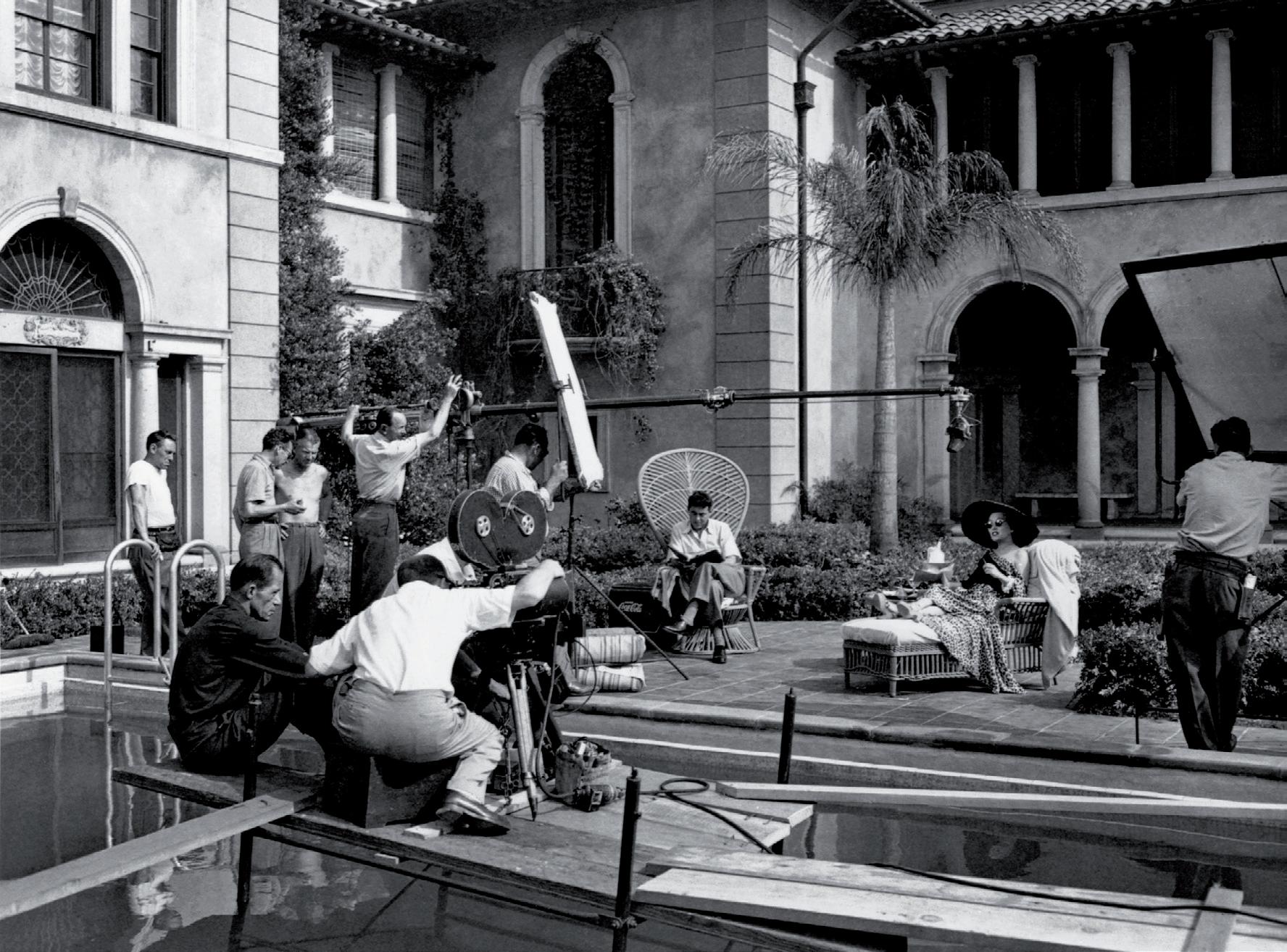
Dat weten we al, omdat hij aan het begin dood in het zwembad van Norma drijft. Een heel mooi, gecompliceerd shot, in elkaar gezet door noir-specialist en Wilder-routinier John F. Seitz; ze werkten al samen bij Double Indemnity en ook





 Het draaien van Sunset Boulevard : rechts Gloria Swanson, midden William Holden in tuinstoel. Billy Wilder staat achter de camera, links zijn director of photography John F. Seitz
Het draaien van Sunset Boulevard : rechts Gloria Swanson, midden William Holden in tuinstoel. Billy Wilder staat achter de camera, links zijn director of photography John F. Seitz




Zoals iedere professie kent ook de filmwereld zijn vakjargon. Paul
Actie! – Als je een scène gaat draaien roept de regieassistent eerst: ‘Camera’. Die wordt dan ingeschakeld. Vervolgens roept hij: ‘Geluid’, waarna de geluidsopname wordt gestart. En ten slotte roept hij (of de regisseur zelf): ‘Actie!’ Dat is het moment waarop de acteurs beginnen te acteren. Overigens: draaien is tegenwoordig een relatief begrip. Er komt geen filmrol meer aan te pas, alles gaat digitaal.



B-film – Meestal een film die voor een laag budget en met minder bekende acteurs/actrices wordt gemaakt. Je zou zeggen: een ‘goedkope’ film. Toch kan zo’n film soms boven zichzelf uitstijgen, zoals Robert Aldrichs Kiss Me Deadly of Orson Welles’ Touch of Evil – al had de laatste titel wel bekende acteurs. Zelfs Hitchcocks Psycho zou je een B-film kunnen noemen.
Best boy – De belangrijkste assistent van de gaffer (zie aldaar).
Blue screen – Blauw scherm dat achter de acteurs wordt opgesteld. Als je de scène eenmaal hebt gedraaid kan dit blauwe scherm digitaal worden ingevuld met ander bewegend beeld. Stel: het script schrijft voor dat een gevaarlijke explosie vlak bij de acteurs moet plaatsvinden. Je kunt deze scène dan eerst met de acteurs in de studio draaien, opgesteld voor het blauwe scherm. Vervolgens draai je de explosie apart op de juiste locatie. Daarna kun je deze twee beelden over elkaar heen leggen, en is het net of de acteurs vlak bij die explosie staan.




Box-office – Geeft aan hoeveel geld er per dag, week, of jaar is binnengekomen aan de kassa’s van alle bioscopen waar de film vertoond wordt.
Callsheet – Een rooster dat aan het einde van elke werkdag wordt uitgereikt aan de gehele crew en cast. Er staat precies op hoe laat en waar iedereen de volgende dag moet zijn.
Cameo – Als een heel bekende acteur/actrice – zeg een ‘ster’ – een klein rolletje in een film speelt. Kan ook een bekend iemand zijn uit een andere discipline dan speelfilm. Hitchcock maakte er een gewoonte van in elk van zijn eigen films een minuscule cameo te doen.
Cast – Alle acteurs/actrices die meewerken aan een film.
persoonlijkheid als Martine kende eenzelfde soort gevoelens tijdens de zwangerschap van onze twee dochters.
Dat gegeven maakt de film universeel. En dat-ie in 1968 is gedraaid mag ook relevant worden genoemd: de jaren dat door het gebruik van thalidomide op grote schaal bij pasgeborenen ernstige afwijkingen werden geconstateerd, de zogeheten Softenon-baby’s. Zulke zaken resoneerden bij het zien van deze film allemaal mee in het achterhoofd van het toenmalige publiek. En zo legt een in wezen onwaarschijnlijk verhaal dan toch een stevige link met de werkelijkheid.

Regisseur Roman Polanski heeft Rosemary’s Baby bekwaam in elkaar gezet. Ik mag wel zeggen: met de Zwitserse precisie van een mechanisch uurwerk. Alles verwijst naar elkaar, geen ontwikkeling of handeling is toevallig. Die precisie bij het aandraaien van de schroeven laat weinig ruimte voor de personages, uitgezonderd Mia Farrow. Alle overige acteurs staan geheel en al in dienst van de plot, ze kunnen zich weinig vrijheden permitteren. Ze zijn vooral bezig met het geven van hints aan het publiek.

Iedere vijf minuten stuurt Polanski erop aan dat wij weer andere verdenkingen krijgen: wat willen die opdringerige buren Minnie en Roman Castevet toch?
En: wat is er aan de hand met Mia? Waarom doet ze zo nerveus? Heeft dat te maken met de hormonen, of met het merkwaardige kruidje dat Minnie haar om de nek heeft gehangen? Wat zit er in die chocolademousse? Is dokter Sapirstein wel zo betrouwbaar, of levert hij ook diensten aan de satanische sekte? O jee, nu begint Mia ook al rauwe lever te eten! Wat zou er met die baby zijn? Kan dit wel goed aflopen, allemaal?
Vooral bij een tweede, derde keer herzien valt op hoe overgeconstrueerd Rosemary’s Baby is. Deels is dat inherent aan het genre: een thriller werkt nu eenmaal volgens vaste wetten. Eerst de intrige opbouwen, allerlei mensen verdacht maken, dat weer ontkrachten, en dan vervolgens alles nogmaals op zijn kop zetten. Ik zie Rosemary’s Baby graag, maar ik vind Hitchcocks Vertigo binnen dit occulte genre superieur.
‘Met uitzondering van Mia Farrow staan alle acteurs geheel in dienst van de plot.’Polanski regisseert Ruth Gordon als Minnie Castevet: haar rol van diabolische buurvrouw was goed genoeg voor een Oscar
En dat komt in het bijzonder door het einde. Daar geeft Polanski de ambiguïteit die hij zo lang zorgvuldig heeft opgebouwd zomaar op. Het satanskind is geboren, ze hebben Mia verteld dat het een miskraam was. Maar ze hoort gehuil in het appartement naast haar, en dan sluipt ze naar binnen, een mes in de hand. Daar staat het wiegje, in duivels zwart, en met een omgekeerde crucifix erboven. Satanisten uit alle windstreken hebben zich in het appartement verzameld. Ook heel exotische, zwarte mensen, dat zijn natuurlijk de drie koningen uit het kerstverhaal. Die omdraaiing wordt tot het bittere einde volgehouden. Mia kijkt in het wiegje, en schrikt zich het apelazerus.







Panoramaview: de jonge ‘heks’ gaat op de brandstapel
God (“Ik wil kennis, niet zomaar iets aannemen, ik wil dat Hij zijn hand naar mij uitstrekt”), geeft de ridder en passant en vooral heel onhandig zijn komende schaakzetten weg.
Aan het slot van de film volgt het eindspel. Met zijn reisgezelschap heeft Block bijna zijn kasteel bereikt, ze zetten hun kamp op in het bos. Daar verschijnt de Dood wederom. De partij moet nog worden voltooid, is het niet? Op het schaakbord staat het allemaal vrij hopeloos voor de ridder, en hij ziet dat ook in. Met een veeg van zijn mantel gooit hij pardoes alle stukken om.


De Dood is daar niet van onder de indruk, hij weet nog precies hoe alles stond. Maar wat hij niet weet is dat de ridder hiermee een afleidingsmanoeuvre creëert, het is een humanistisch gebaar. Door de ontstane verwarring krijgt het stel Jof en Mia nét genoeg tijd om met hun zoontje per huifkar weg te glippen. Of: misschien weet de Dood dat ook wel, en laat hij het gebeuren. Alsof Bergman wil zeggen: vergeet alle hoogdravend filosofisch getob, zoek het geluk in het kleine. Zoek het in oprechte vriendschap, in liefde, en waarschijnlijk heeft de altijd zo getourmenteerde regisseur het hier eerst en vooral tegen zichzelf.
Dan is de Dood weer aan zet: pats! Schaakmat!
“Ik laat je nu met rust,” besluit hij. “De volgende keer dat ik je zie zit je tijd erop.”

‘Alsof Bergman wil zeggen: vergeet alle filosofisch getob.’




uitgever
General Glass
auteur
Richard Meitner
formaat
23,5x30,5
jaar van publicatie
2001
bijzonderheden
Deze monografie van Richard Meitner bevat een overzicht van zijn werk tot op dat moment. Voor de indeling van het boek heb ik nauw met hem samengewerkt om tot een mooie compositie te komen waarbij tekst en beeld zich op de juiste wijze verhouden. Hij werkt onder meer met glas en dat heeft als complicatie dat de fotografie (Ron Zijlstra) uitmuntend moet zijn om de belichting geen invloed te laten hebben op de kleuren van de objecten. Daarnaast is het noodzakelijk om van de scans proefdrukken te beoordelen en daarna met de kunstenaar aan de pers te gaan staan om daar het uiteindelijke beeld waar nodig nog bij te sturen. Een complete versie van dit boek is te bekijken via http://issuu. com/stevenboland/docs/richard_meitner_300

co nfro nt it or defor m it with bro nz e or steel, setting up hateful tensio ns - and it hardly seems necessary to remind our selves tha t love and ha te are so dangerously c lose But all of these pairings are do ne with affectio n and admir atio n for so ver satile a material
His approach to me was “would you co nsider writing something about my work for this book?” VIII Like a shot – but I ag reed o nly after a weekend’s very careful co nsider atio n One doesn’t tread unwarily into this testing, tantalising ter ritory
I Letter from JO to RM
II Lecture, Royal College of Art, October,
III Ibid Some g remlin intervened and all the slides for this lecture were shown in rever se His extreme co ncer n over this fur ther ser ved to emphasise his interest in the opportunity to very precisely manipulate the image
IV Ibid and Klein, D: Richard Meitner’s Cabinet of Curiosities’, Vetro, June , pp - Meitner is proud always to mentio n his g rea t-aunt Lise Meitner ‘largely responsible for the discovery of nuclear fission’
V Ibid
VI Ibid
VII Lecture RCA
VIII ‘Agog’, e-mail from RM to JO, Fri, //



Toutes ces associatio ns so nt néanmoins effectuées avec l’affection et l’admiration qu’il ressent pour un matériau aussi plastique Il me co ntacta pour me demander: «Envisa gerie z-vous d’écrire un texte pour le livre co nsacré à mo n tr avail?VIII» Sans hésita tio n Mais je do nnai mo n accord après un week-end de mûre réflexio n: o n ne s’aventure pas à la légère sur des ter ritoires aussi exigeants et élusifs
I Lettre de J O à R M du juillet
II Conférence au Royal College of Arts, octobre
III Ibidem Une er reur de manipulation a inversé l’ordre des diapositives de la co nférence, à la g r ande inquiétude de Meitner, ce qui co nfir me so n goût pour une manipulation très précise de l’image

IV Ibidem et Klein D : Richard Meitner’s Cabinet of Curiosities, in Vetro, juin , pa ges - Meitner est toujour s fier de parler de sa g r and-tante, Lise M eitner, «co-inventeur de la fission nucléaire»
V Ibidem
VI Ibidem
VII Conférence au Royal College of Arts
VIII E-mail de R M à J O , vendredi mars
Jennifer Hawkins Opie Jennifer Hawkins OpieDeputy Curator Victoria & Albert Museum, April
e a e b d c e a d c b e a b c d
b e d a c a d b c e
b e d a c
c b e d a a c b e d e d a c b d e c b a e d a b c a e c d b d c a b e a e c d b b a e c d d b a e c e c d b a
Conservateur adjoint, Victoria and Albert Museum, avril a b c d e c a e b d b e c d a c a e b d d c a e b b d c a e a e b d c e a d c b e a b c d b e d a c a d b c e b e d a c c b e d a a c b e d e d a c b d e c b a e d a b c a e c d b d c a b e a e c d b b a e c d d b a e c e c d b a c e b a d c e d a b d c b e a e b d a c d c b e a a d c b e e a d c b c b e a d

Two winter s a go I sat in the libr ary of the Museum of Decor ative Arts in Pra gue and thought about Richard Meitner’s work The reading room is a ma gnificent open space tha t has not changed much in appearance since the end of the th-century Pr a gue is about bewilder ment and the room is a good place to sit and try to under stand Fr anz K af ka liked to read there too and in between my big thoughts, I often wo ndered if my posterior was r ubbing the same Tho net chair seat as had Kafka’s
The libr ary holds extensive ‘Meitneresque’ resources in the for m of old publica tio ns o n Cz ec h industrial glass There are articles about apparatus destined for chemical and phar maceutical companies. The complica ted flameworked systems of borosilica te glass are able to withstand extreme and sudden c hanges in temper a ture and are designed for the circula tio n and distillation of liquids Advertisements for vapor separators, u-bends, g r adua ted c ylinder s, pipettes and filter s promise stability, unifor mity and precisio n


Since , Meitner’s medium of c hoice has also been flameworked heat-resistant glass modeled to his specificatio ns by instr ument maker Edwin Dieperink While often anthropomorph iz ed into animals, plants and people or tur ned into votive bottles, the basic shapes are workhorse beakers, flasks, bubbling alembics, retor ts, bell jar s, ther mometer s and light bulbs

At fir st glance, Meitner’s sculptures, like their labware cousins, appear to be str aightforward and le gible objects They are centered, calm and ele g ant composites of f amiliar items invariably in some for m of the vessel Since the la te s, a seco nd look has made it c lear tha t Meitner is not par t of the “Happy Glass Gang”. Bubbles with dangling root stoppers were the fir st sign, followed by a series of small stumpy cups The cups are tightly co ntrolled, diminutive in scale, largely opaque, and display richly detailed surface ‘dr awings ’ Their precious and subtle clunkiness had more in commo n with the cer amics of Cali for nian Ro n Na gle than anything in the co ntempor ary studio glass scene Twenty years later, the play between interior and exterior – a cut rim revealing a brilliant or ange lining, the slow f ading away of a tendril behind tr anslucent walls – still feels new and distinct
When Meitner followed with softly collapsing c ylinder s decor ated with ‘trompe-l’oeil’ snarling beasts, gilding, mir roring and pene tr a ted by painted wooden fish, the work became and remained stubbor nly indecipher able A ba g with a small hooked ar m dr a g ging a c hained car rot? 5 A lizard filled with blue water? Photo-tr ansfer s applied with the density of chintz slipcover s?52 The comfor ting domestic war mth of cute lumpy animals, blue and white Delft tiles 8 , night lights and cor ny figurines proved to be just ‘off ’ enough to for m an unsettling

Il y a deux hiver s de cela, je me trouvais à la bibliothèque du musée des Ar ts décor atifs de Pr a gue, méditant sur le tr avail de Richard Meitner La salle de lecture est un volume ma gnifique, resté apparemment inchangé depuis la fin du e siècle Prague est une ville qui incite à se poser des questions et la bibliothèque est un bo n endroit pour essayer de comprendre Fr anz K af ka aimait à y tr availler et, lor sque je f aisais une pause, je me demandais souvent si mo n auguste postérieur était posé sur la chaise de Tho net où Kafka s’était précisément assis Cette bibliothèque détient une documenta tio n exhaustive que je qualifierais de «meitnéresque», sous la for me d’anciennes publications sur le ver re industriel tchèque On y trouve des articles sur des appareils destinés à l’industrie chimique et pharmaceutique Ces instr uments compliqués en ver re borosilicate f aço nné au c halumeau peuvent résister à des varia tio ns soudaines et extrêmes de tempér a ture et so nt co nçus pour la circulatio n et la distillatio n des liquides Des encar ts publicitaires pour les sépar ateur s de g az, des tubes en U, des c ylindres g r adués, des pipettes et des filtres fo nt miroiter la stabilité, la permanence et la précisio n
Depuis








, le matériau choisi par Meitner est ce ver re résistant à la chaleur, façonné au chalumeau, travaillé selon ses directives par l’ouvrier verrier Edwin Dieperink Même si elles ont souvent la for me d’animaux, de plantes et d’hommes ou de bouteilles «votives», les for mes de base sont celles des béchers, alambics bouillants, cor nues, cloches, ther momètres et ampoules
Au premier reg ard, les sculptures de Meitner, comme leurs homologues de laboratoire, semblent des objets simples et lisibles Ce sont des ensembles équilibrés, posés et élég ants d’artic les f amilier s qui prennent toujour s une for me de récipient Depuis la fin des années , un examen plus approfondi révèle que Meitner ne fait pas partie de la Bande de «Happy Glass» En témoignent ces vases munis de bouchons or nés de racines pendantes qui furent suivis par une série de petites coupes Ces coupelles/coupes so nt des pièces très maîtrisées, de taille réduite, presque opaques et elles mo ntrent sur leur surf ace des dessins riches de détails. Leur caractère précieux et subtil avait beaucoup plus de points communs avec les cér amiques du Califor nien Ro n Na gle que toute autre pièce co ntempor aine en ver re Vingt ans après, l’inter actio n entre l’intérieur et l’extérieur – un bord coupé qui révèle un intérieur orange vif, la disparition prog ressive d’une for me en vrille der rière des parois translucides – g arde encore son caractère novateur et original Quand Meitner en ar riva à ses cylindres qui ont l’air de s’affaisser lentement, or nés de trompe-l’œil, de bêtes menaçantes, de dorures, de miroirs et transpercés de poissons de bois peint, so n tr avail devint, et per siste à rester indéc hiffr able Un vase avec un croc het auquel est enc haînée une carotte?5 Un lézard rempli de liquide bleu? Des décalcomanies appliquées avec la régularité que l’on retrouve sur des coussins en chintz?52 La quiétude domestique de ces mignons petits animaux, de ces carreaux de Delft bleu et blanc 8 , de ces lanter nes et autres figurines ring ardes étai suffisamment décalé pour for mer un foiso n-


































–––––––––––––––––––––––––––––––––––––––––––––––––––––––––––––––––––––––––––––––––––––––––––––––––––––––––––––––––––––––––––––––––––––––––––––––––––––––––––––––––––––––––––––––––––––H I S T O R Y –––––––––––––––––––––––––––––––––––––––––––––––––––––––––––––––––––––––––––––––––––––––––––––––––––––––––––––––––––––––––––––––––––––––––––––––––––––––––––––––––––––––––––––––––––––1 9 9 5 –––––––––––––––––––––––––––––––––––––––––––––––––––––––––––––––––––––––––––––––––––––––––––––––––––––––––––––––––––––––––––––––––––––––––––––––––––––––––––––––––––––––––––––––––––––H 2 1 C M W 7 6 C M –––––––––––––––––––––––––––––––––––––––––––––––––––––––––––––––––––––––––––––––––––––––––––––––––––––––––––––––––––––––––––––––––––––––––––––––––––––––––––––––––––––––––––––––––––––
–––––––––––––––––––––––––––––––––––––––––––––––––––––––––––––––––––––––––––––––––––––––––––––––––––––––––––––––––––––––––––––––––––––––––––––––––––––––––––––––––––––––––––––––––––––N
–––––––––––––––––––––––––––––––––––––––––––––––––––––––––––––––––––––––––––––––––––––––––––––––––––––––––––––––––––––––––––––––––––––––––––––––––––––––––––––––––––––––––––––––––––––
1 9 7 8

–––––––––––––––––––––––––––––––––––––––––––––––––––––––––––––––––––––––––––––––––––––––––––––––––––––––––––––––––––––––––––––––––––––––––––––––––––––––––––––––––––––––––––––––––––––H 1 1 C M –––––––––––––––––––––––––––––––––––––––––––––––––––––––––––––––––––––––––––––––––––––––––––––––––––––––––––––––––––––––––––––––––––––––––––––––––––––––––––––––––––––––––––––––––––––
–––––––––––––––––––––––––––––––––––––––––––––––––––––––––––––––––––––––––––––––––––––––––––––––––––––––––––––––––––––––––––––––––––––––––––––––––––––––––––––––––––––––––––––––––––––
8 4 –––––––––––––––––––––––––––––––––––––––––––––––––––––––––––––––––––––––––––––––––––––––––––––––––––––––––––––––––––––––––––––––––––––––––––––––––––––––––––––––––––––––––––––––––––––H 3 4 C M –––––––––––––––––––––––––––––––––––––––––––––––––––––––––––––––––––––––––––––––––––––––––––––––––––––––––––––––––––––––––––––––––––––––––––––––––––––––––––––––––––––––––––––––––––––
1 –––––––––––––––––––––––––––––––––––––––––––––––––––––––––––––––––––––––––––––––––––––––––––––––––––––––––––––––––––––––––––––––––––––––––––––––––––––––––––––––––––––––––––––––––––––2 –––––––––––––––––––––––––––––––––––––––––––––––––––––––––––––––––––––––––––––––––––––––––––––––––––––––––––––––––––––––––––––––––––––––––––––––––––––––––––––––––––––––––––––––––––––3 –––––––––––––––––––––––––––––––––––––––––––––––––––––––––––––––––––––––––––––––––––––––––––––––––––––––––––––––––––––––––––––––––––––––––––––––––––––––––––––––––––––––––––––––––––––4 –––––––––––––––––––––––––––––––––––––––––––––––––––––––––––––––––––––––––––––––––––––––––––––––––––––––––––––––––––––––––––––––––––––––––––––––––––––––––––––––––––––––––––––––––––––
–––––––––––––––––––––––––––––––––––––––––––––––––––––––––––––––––––––––––––––––––––––––––––––––––––––––––––––––––––––––––––––––––––––––––––––––––––––––––––––––––––––––––––––––––––––
–––––––––––––––––––––––––––––––––––––––––––––––––––––––––––––––––––––––––––––––––––––––––––––––––––––––––––––––––––––––––––––––––––––––––––––––––––––––––––––––––––––––––––––––––––––1 9 8 4 –––––––––––––––––––––––––––––––––––––––––––––––––––––––––––––––––––––––––––––––––––––––––––––––––––––––––––––––––––––––––––––––––––––––––––––––––––––––––––––––––––––––––––––––––––––H 6 5 C M –––––––––––––––––––––––––––––––––––––––––––––––––––––––––––––––––––––––––––––––––––––––––––––––––––––––––––––––––––––––––––––––––––––––––––––––––––––––––––––––––––––––––––––––––––––
–––––––––––––––––––––––––––––––––––––––––––––––––––––––––––––––––––––––––––––––––––––––––––––––––––––––––––––––––––––––––––––––––––––––––––––––––––––––––––––––––––––––––––––––––––––W I S D O M –––––––––––––––––––––––––––––––––––––––––––––––––––––––––––––––––––––––––––––––––––––––––––––––––––––––––––––––––––––––––––––––––––––––––––––––––––––––––––––––––––––––––––––––––––––1 9 9 4 –––––––––––––––––––––––––––––––––––––––––––––––––––––––––––––––––––––––––––––––––––––––––––––––––––––––––––––––––––––––––––––––––––––––––––––––––––––––––––––––––––––––––––––––––––––H 4 4 C M –––––––––––––––––––––––––––––––––––––––––––––––––––––––––––––––––––––––––––––––––––––––––––––––––––––––––––––––––––––––––––––––––––––––––––––––––––––––––––––––––––––––––––––––––––––
–––––––––––––––––––––––––––––––––––––––––––––––––––––––––––––––––––––––––––––––––––––––––––––––––––––––––––––––––––––––––––––––––––––––––––––––––––––––––––––––––––––––––––––––––––––
O –––––––––––––––––––––––––––––––––––––––––––––––––––––––––––––––––––––––––––––––––––––––––––––––––––––––––––––––––––––––––––––––––––––––––––––––––––––––––––––––––––––––––––––––––––––
1 9 9 5 –––––––––––––––––––––––––––––––––––––––––––––––––––––––––––––––––––––––––––––––––––––––––––––––––––––––––––––––––––––––––––––––––––––––––––––––––––––––––––––––––––––––––––––––––––––H 7 5 C M –––––––––––––––––––––––––––––––––––––––––––––––––––––––––––––––––––––––––––––––––––––––––––––––––––––––––––––––––––––––––––––––––––––––––––––––––––––––––––––––––––––––––––––––––––––
5 –––––––––––––––––––––––––––––––––––––––––––––––––––––––––––––––––––––––––––––––––––––––––––––––––––––––––––––––––––––––––––––––––––––––––––––––––––––––––––––––––––––––––––––––––––––6 –––––––––––––––––––––––––––––––––––––––––––––––––––––––––––––––––––––––––––––––––––––––––––––––––––––––––––––––––––––––––––––––––––––––––––––––––––––––––––––––––––––––––––––––––––––7 –––––––––––––––––––––––––––––––––––––––––––––––––––––––––––––––––––––––––––––––––––––––––––––––––––––––––––––––––––––––––––––––––––––––––––––––––––––––––––––––––––––––––––––––––––––
–––––––––––––––––––––––––––––––––––––––––––––––––––––––––––––––––––––––––––––––––––––––––––––––––––––––––––––––––––––––––––––––––––––––––––––––––––––––––––––––––––––––––––––––––––––W I W A R –––––––––––––––––––––––––––––––––––––––––––––––––––––––––––––––––––––––––––––––––––––––––––––––––––––––––––––––––––––––––––––––––––––––––––––––––––––––––––––––––––––––––––––––––––––1 9 9 7 –––––––––––––––––––––––––––––––––––––––––––––––––––––––––––––––––––––––––––––––––––––––––––––––––––––––––––––––––––––––––––––––––––––––––––––––––––––––––––––––––––––––––––––––––––––H 6 2 C M –––––––––––––––––––––––––––––––––––––––––––––––––––––––––––––––––––––––––––––––––––––––––––––––––––––––––––––––––––––––––––––––––––––––––––––––––––––––––––––––––––––––––––––––––––––
–––––––––––––––––––––––––––––––––––––––––––––––––––––––––––––––––––––––––––––––––––––––––––––––––––––––––––––––––––––––––––––––––––––––––––––––––––––––––––––––––––––––––––––––––––––
–––––––––––––––––––––––––––––––––––––––––––––––––––––––––––––––––––––––––––––––––––––––––––––––––––––––––––––––––––––––––––––––––––––––––––––––––––––––––––––––––––––––––––––––––––––D E L F T B L U E –––––––––––––––––––––––––––––––––––––––––––––––––––––––––––––––––––––––––––––––––––––––––––––––––––––––––––––––––––––––––––––––––––––––––––––––––––––––––––––––––––––––––––––––––––––
1 9 9 7





–––––––––––––––––––––––––––––––––––––––––––––––––––––––––––––––––––––––––––––––––––––––––––––––––––––––––––––––––––––––––––––––––––––––––––––––––––––––––––––––––––––––––––––––––––––
8














uitgever
New In Chess
auteur
formaat
16,5x24
jaar van publicatie
2006-2010
bijzonderheden
Voor het tijdschrift New In Chess werd eind 2005 een compleet nieuwe lay-out ontworpen inclusief een herontwerp van het logo van het tijdschrift en de gelijknamige uitgeverij. Tegelijkertijd ging het blad voortaan verschijnen als full-color uitgave. Vanuit het basisstramien werkte ik voor elk nummer van dit 8-maal per jaar verschijnende tijdschrift telkens de openingsspread van de stukken uit die dan door de lay-outer werden verwerkt. Daarnaast keek ik het resultaat van het gehele nummer nog na en gaf aanwijzingen voor fotoformaten, gebruik van streamers en wat dies meer zij. Uiteraard werd ook ieder nummer het omslag ontworpen in nauwe samenwerking met de uitgever.

8 One More 25th Anniversary
ACoinciding with our 25th anniversary, Garry Kasparov and Anatoly Karpov celebrated that their unique rivalry also started a quarter of a century ago, with an exhibition match in Valencia.


18 Carlsen Breaks 2800 Barrier

Now that we knew he was working with Kasparov all eyes were on Magnus Carlsen when he arrived in Nan jing. What happened next can only be described as his toric. Playing with unrestrained ambitions in every game the Norwegian outclassed a category 21 field with a 3002(!) performance.
24 Anand’s Favourite Websites
What websites does the current World Champion visit to read up on his interests outside of chess?
28 Is 40 the New 20?
Following a severe form crisis Vasily Ivanchuk bounced back to win the Jermuk Grand Prix. Runner-up Levon Aronian secured the top spot in the overall GP standings.
52 New In Chess And I
It was heart-warming and gratifying to see that New In Chess means so much to our readers. Here are the winners.
56 Have You Ever Been Experienced?
An invitation to play in the NH tournament convinced Pe ter Svidler that he was now officially Experienced. Both as a grandmaster and as a prolific writer, we may add.
76 Mikhail Botvinnik, Homo Politicus
Genna Sosonko reveals a lesser known side of the former world champion, a man of unshakable political convictions.
85 S.O.S.: Preparing the Staunton Gambit
Jeroen Bosch proposes 2.f3!? against the Dutch Defence.

90 Lev On A Roll Again
Having lost his first game he steamrolled the field to finish first with one round to spare. Levon Aronian was in a class of his own at the Grand Slam Final in Bilbao, posting yet another major victory in a year that he calls his best so far.
 PUBLISHER : Allard Hoogland EDITORS-IN-CHIEF : Dirk Jan ten Geuzendam, Jan Timman
PUBLISHER : Allard Hoogland EDITORS-IN-CHIEF : Dirk Jan ten Geuzendam, Jan Timman
Champions’ League in Zurich
Vladimir Kramnik not only won the star-studded rapid tournament in Zurich, he also had a great time seeing his colleagues again.
The Oldest Chess Club
Richard Forster’s book on the history of the Zurich Chess Club brought Hans Ree back to that bright evening when he saw Mikhail Tal for the first time.
Of Old Dogs and an Englishman
He may poke fun at his diminished powers, but at 44 Nigel Short is enjoying a second youth.
Bring Back the Cold War!
Jonathan Rowson wonders what is needed to revive chess as a sport that attracts global interest.

Top Giri
Fifteen-year-old Anish Giri became the youngest Dutch champion in history.

Bobby Fischer’s Openings

The American champion never explained how he thought about openings. But he left clues.
Recent Endgames that Caught the Eye
Join Jan Timman in his endgame laboratory.
Of Once and Future Kings
Garry Kasparov looks back on his reunion with Karpov and does not hide his pride about Carlsen’s stellar performance in Nanjing.
Just Checking
Guess what’s Veselin Topalov’s biggest fear?

CONTRIBUTORS TO THIS ISSUE
Vishy Anand, Levon Aronian, Jeroen Bosch, Magnus Carlsen, Boris Gelfand, Anish Giri, Alexander Grischuk, Vasily Ivanchuk, Sergey Karjakin, Rustam Kasimdzhanov, Garry Kasparov, Vladimir Kramnik, Peter Leko, Hans Ree, Jonathan Rowson, Nigel Short Jan Smeets, Andy Soltis, Genna Sosonko, Peter Svidler, Jan Timman, Veselin Topalov
PHOTOS AND ILLUSTRATIONS
Frank Brady, Henrik Carlsen, Mark Huba, Arman Karakanyan, Al Lawrence, Hanon Russell, Mattis Sandblad/SCANPIX, ‘64’, Schachgesellschaft Zürich





COVER PHOTO


Magnus Carlsen: New In Chess
100
120
124
136
Vasily Smyslov 1921-2010




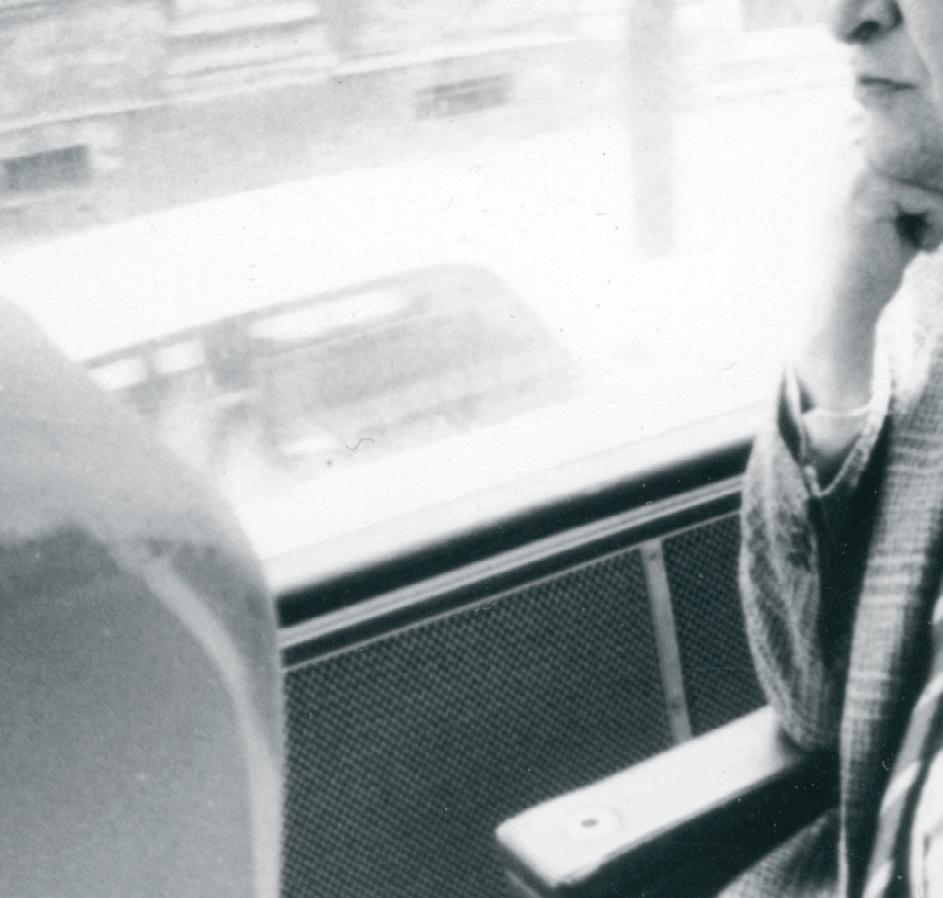



Vilnius, March 1984. Twenty-seven years after he won the World Championship, Vasily Vasilievich Smyslov is on his way to the Candidates Final Match. His opponent, Garry Kasparov, is sitting behind him. At 63 Smyslov is easily the oldest Candidate in chess history. Kasparov is 20, the next year he will defeat Karpov to claim the world title. Vasily Smyslov died on March 27, three days after his 89th birthday. In a first reaction Vladimir Kramnik said: ‘Smyslov was a big figure in the world of chess. Not only because of his peak years, but also because he was one of the best players in the world at the age of 63. Nobody will ever achieve that anymore. Smyslov was no less a player than Tal or Petrosian. Even no less, I would dare to say, than Fischer. Fischer was a brighter star, but Smyslov shone much longer. In my opinion he is the best player for young kids to study. His games are so clean and clear. They were never seriously analyzed with the computer, but my feeling tells me that he was very, very good. Even the computer would not refute the majority of his games.’
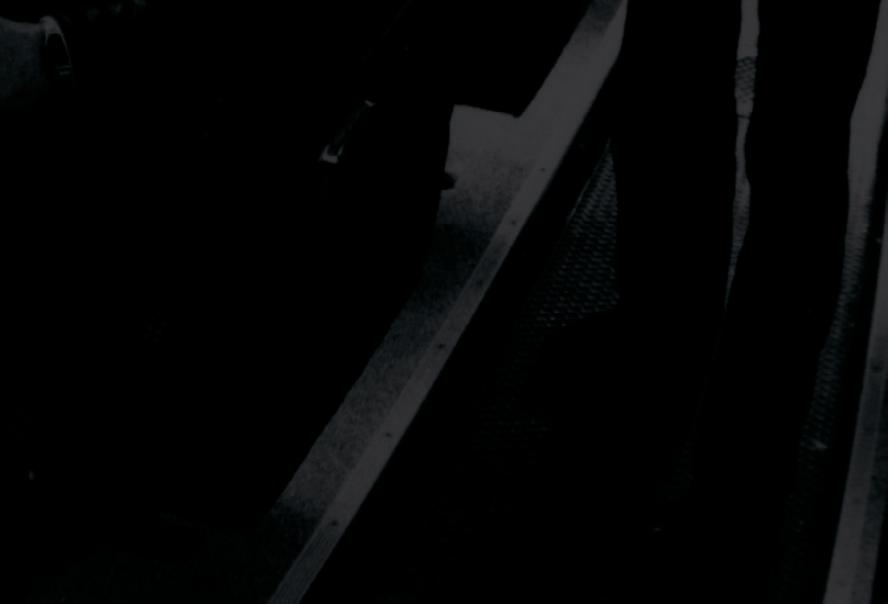







Lev On A Roll Again










He arrived as a last-minute substitute for the world’s number one, lost his first game and then steamrolled the field to finish first with one round to spare. Levon Aronian was in a class of his own at the Grand Slam Final in Bilbao, posting yet another major victory in a year that he calls his best so far. Was it his uncanny natural talent that propelled him to victory or his gift to shake off defeats easily? Or was it the Australian air that he inhaled during a mental training session driving 1500 kilometres from the Gold Coast to Canberra with his second Alex Wohl?

lin Topalov, last year’s winner in Nanjing.


Topalov’s withdrawal could be directly attributed to the financial crisis that had plagued the organizers right from the moment they started to work on the second Grand Slam Final. It didn’t take them long to fi nd out that in no way they would be able to match the amazing 400,000 euro prizefund of last year. Forced to downsize their budget their first decision was to reduce the number of players, which effectively meant that they lost two wild-cards and could not invite Anand and Carlsen. By way of compensation they at first didn’t reduce the length of the tournament and proposed a final match between the numbers one and two to determine the 2009 Grand Slam winner. But this plan had to be abandoned as well, as the money saved by shortening the event was more than welcome. And fi nally they had to dramatically lower the prizes, with first prize plummeting from 150,000 euro to 35,000 euro. This drop compounded their problems, as on the eve of the event Topalov announced that this first prize was unacceptable for him and his place was given to the runner-up in Nanjing, Aronian.

Geuzendam
At first glance the Plaza Nuevo in the heart of the old centre of Bilbao offered a familiar sight. One year after the inaugural Grand Slam Final the glass sound-proof cabin (‘la urna’) had been erected again and every day at the end of the afternoon a crowd of people filled the square. Chess enthusiasts came to watch the grandmasters and listen to Leontxo Garcia’s captivat-
ing live commentary, while sauntering couples came to bask in the sinking sun and watch their children play. Still there was a telling difference. Instead of six players there were only four occupying the chess tables in the cabin and last year’s crowd-pullers, Anand, Topalov and Carlsen, were absent.
The protagonists this time were Sergey Karjakin, Alexander Grischuk and Alexey Shirov, respectively the winners of the Grand Slam tournaments in Wijk aan Zee, Linares and Sofia, plus Levon Aronian, who replaced Vese-

With four players the doubleround tournament was reduced to a sprint of six games in which any loss could have dire consequences. Or so it seemed, as the race took a most miraculous course. Who could have thought that Alexander Grischuk, who started with two wins over Aronian and Shirov, would not even have a chance to share first place at the start of the sixth and final round? And who would have thought that Aronian, who started with a loss, would clinch victory after a mere five rounds, irrespective of his re-
BILBAO B 27
15-10-09 17:39








Fischerandom, or Chess960, was not an original idea of Bobby Fischer’s. In fact, the first person who proposed to put the pieces on the first rank by lot in the initial position was the Dutch nobleman
Jules van Zuylen van Nyevelt in his book La supériorité des échecs mise à la portée de tout le monde et particulièrement des dames (The superiority
of chess made accessible to the entire world and particularly to the ladies), which was published in 1792. His idea was further promoted by his nephew, Elias van der Hoeven, who in 1851 played a game in this manner against Von der Lasa. But the first important game conducted in this way was between Marshall and Cohn, in Berlin, in November 1911.
Adolivio Capece
This and many more curiosities can be found in the 100 vol umes of the Italian chess maga zine L’Italia Scacchistica more precise, in the first 99. The hundredth is still in progress, as the magazine celebrates its cen tenary in the autumn of this year.
, or, to be
was estab-

L’Italia Scacchistica lished in Florence by Marquis Ste fano Rosselli del Turco in the au tumn of 1910. The first issue was published in early January 1911.
Stefano Rosselli del Turco, who was born in Florence in 1877, and died there in 1947, was Ital ian champion in the years 1923-28 and 1931-33. He played in five Ol ympiads and in 1925 he had a fine result in Baden-Baden, where he beat Tarrasch, Colle and Yates.
64 A L’ITALIA SCACCHISTICA












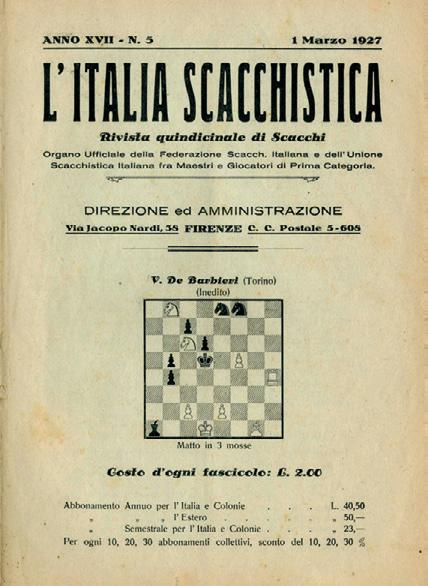





Reeds meer dan 500 boeken verzorgd, Omslag en/of binnenwerk
* Ailantus * Arena * Atlas * Bijleveld * Boom *
* Contact * De Balie * De Bezige Bij * Meulenhoff *
* New In Chess * Nieuw Amsterdam * Pimento * Pearson *
* Sun * Van Gennep * Veen *
Hendrik de Vries * Peter Sloterdijk * Lisa St Aubin de Terán * Germaine Greer *
Wessel te Gussinklo * Jhumpa Lahiri * Paul Verhoeven * Mario Vargas Llosa * Slavoj
Žižek * Jane Jacobs * André Brink * Kees Fens * Jean-Marie Blas de Roblès * Vikas
Swarup * David Mitchell * Francis Ponge * Lieven de Cauter * Erich Fromm * Adriaan
van Dis * Simon Schama * Salman Rushdie * Michel Foucault * Mirjam Schöttelndreier
* G.P. Hoefnagels * Rob van Scheers * Hermine de Graaff * Wim van de Woestijne *
Teun Voeten * Hans van Dam * John G. Neihardt * Michel Tournier * Fernando Savater
* Luis Buñuel * Kester Freriks * Chris Keulemans * Tony Judt * Abram De Swaan *
Ingmar Bergman * Oscar Wilde * Amos Oz * Lev Tolstoj * Johan van der Keuken *
Gabriël Garcia Llorca * Kenzaburo Oë * Wislava Symborska * Peter Delpeut * Adam
Hochschild * Annejet van der Zijl * Jan Brugman * James Salter * Christien Brinkgreve
* Breyten Breytenbach * Dirk van Weelden * Oliver Sacks * Roel Bentz van den Berg
* Charlotte Mutsaers * Hans van Maanen * Huub Beurskens * Rudy Kousbroek *
Monika van Paemel * E.M. Remarque * Patricia de Martelaere * H.W. von der Dunk *
Arnold Karskens * Kuki Gallmann * Herman Koch * Lieve Joris * Euclides da Cunha *
Robert Greene * Frank Bovenkerk * William Blake * Leo Vroman * Roberto Bolano
* Günther Grass * Aukelien Weverling * Marc Chagall * Rob van der Linden * Douglas
Coupland * Jan Timman * Stephan Sanders * Susan Smit * en vele anderen
* Affiches * Flyers *
* Folders * Websites *
* Tijdschriften *
* Hollands Maandblad * De Nieuwe Kerk Amsterdam *
* Debatcentrum De Balie * Cosmic theater * PTT Post *
* NRC Handelsblad * Glasmuseum Ernsting *
* Braggiotti Gallery * Villa De Bank * NeWeB *
Sinds 1988
* bewezen kwaliteit * onovertroffen snelheid *
* verbluffend scherpe prijs *
* digitale boekverzorging zoals het hoort *

